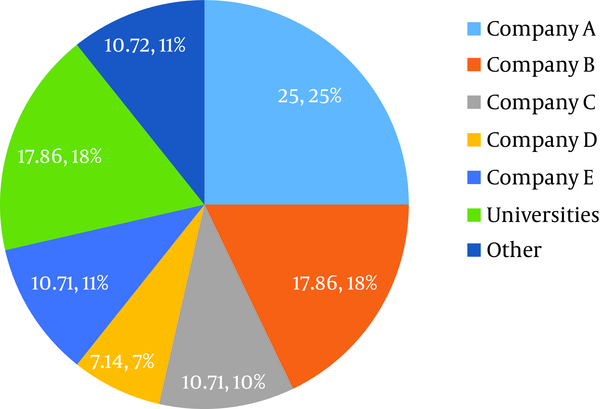1. Background
Despite the extensive efforts of the Iranian Ministry of Health to expand healthcare centers in the country and to distribute medical facilities and equipment appropriately in Healthcare centers in different cities and provinces of Iran, many remote towns and villages and underdeveloped areas are deprived of many specialists and specialized care services (1-4). These people inevitably have to go to larger and more prosperous cities to get many specific services (4). Lack of awareness of the program of physicians and specialties and inability to schedule appointments, especially for citizens in disadvantaged areas, will result in overcrowding in healthcare centers, the risk of communicable diseases, and the loss of patient’s time (5-9). In recent years, with the expansion of the World Wide Web in Iran, even in rural areas, it has been possible to use e-booking systems for healthcare centers (8, 10-12). The use of Internet-based e-booking systems can be a useful tool for achieving the 17 - 19 Health Equity Indicators in Iran (3) that have access to healthcare services. According to the results of a study by researchers in 2016, only 9% of university hospitals in Iran were actively using the online e-booking system (13).
2. Objectives
In this study, we aimed to analyze the situation of e-booking websites in Iranian public clinics.
3. Methods
This descriptive cross-sectional study was conducted in 2019 in 31 provinces, universities of medical sciences, and affiliated health centers (including Tehran, Iran, and Shahid Beheshti Universities of Medical Sciences were studied in Tehran province).
We developed a checklist with 11 items for situation analysis. The content validity of the checklist items was evaluated and approved by five health information management experts. These items included: having an Internet-based e-booking system, having an integrated booking system for the university, having integrated booking system, having an app for booking, the ability to a quick recovery in Google search engine, searchability, user registration, ability to record the demographic and therapeutic information, the security of the domain and online payment gateway (Table 1) (5, 6, 8, 9, 13). Also, the companies of web developers of e-booking systems were reviewed.
To determine the easy finding of the e-booking website links, we searched the phrase of “e-booking website healthcare centers of the medical universities” with Persian terms in the Google search engine as the dominant search engine in Iran (12). If the related link was retrieved on the first page, we conducted it as a website with an easy retrieving website. Moreover, to determine the searchability of the systems, we used five items, including the physician’s name, the specialist, city or town, clinic, and hospital. To assess the security of websites, three factors, including the use of Captcha code, the https domain, and specifying the name of the university, were reviewed.
4. Results
In the present study, just 5 out of 31 (15.15%) provinces and their affiliated universities of medical sciences (Qazvin, Hamedan, Kurdistan, Ilam, and North Khorasan), lacked an e-booking system, which indicated significant growth in the utilization of e-booking system in Iran in recent years. The situation of e-booking websites in Iranian Public Clinics in 11 domains is shown in Table 1.
| Row | Item | Has Feature | Does not Have Feature | ||
|---|---|---|---|---|---|
| Count | Percentage | Count | Percentage | ||
| 1 | E-booking | 28 | 84.85 | 5 | 15.15 |
| 2 | Integrate e-booking portal | 24 | 85.71 | 4 | 14.29 |
| 3 | Uniform e-booking system | 26 | 92.86 | 2 | 7.14 |
| 4 | Mobile-based application | 19 | 67.86 | 9 | 32.14 |
| 5 | Easy finding in web | 26 | 92.86 | 2 | 7.14 |
| 6 | Searchability | 25 | 89.30 | 3 | 10.70 |
| 7 | Membership | 16 | 57.14 | 12 | 42.86 |
| 8 | Enter Socio-demographic data | 26 | 100 | 0 | 0 |
| 9 | Enter clinical data | 1 | 3.57 | 27 | 96.43 |
| 10 | Security of website | 23 | 82.14 | 5 | 17.86 |
| 11 | Online Payment Gateway | 4 | 14.29 | 24 | 85.71 |
The Situation of E-Booking Websites in Iranian Public Clinics
Figure 1 shows the e-booking web developer companies for Iranian Public Clinics (University Hospitals). Based on Figure 1, company “A” had the highest participants in the web development.
5. Discussion
Because of smartphone distribution in Iran (10, 14), it is possible to develop e-booking systems based on the mobile platform, and most medical universities can use it in e-booking (68%). Owing to the low cost of app development, the high acceptance rate in the population, ease of use (15), and its usability in the national network in specific conditions, it is suggested to plan for its more extensive development and use.
Adopting these technologies could be considered a starting point to provide better healthcare services and improve patient satisfaction. For example, a module could be added to the platform that obtains patient evaluation of the provided healthcare services. These modules, alongside each other, could lead to the creation of a patient-engaging environment that results in the provision of better healthcare services. Furthermore, they could form a valuable data repository for further analysis (7, 9, 16).
The results of the current study indicated that 85.71% of the centers studied had an integrated e-booking portal. The present study was a continuation of the aim of previous research. However, this result has not previously been described because the last situation completely changed. Samadbeik et al. (12) evaluated online outpatient appointment systems in Iran in 2017. The results of Samadbeik et al. (12) study showed that the outpatient booking systems in Iranian hospitals were based on traditional methods. Also, they reported that only 7 universities of medical sciences in Iran used e-booking systems in 2017. These changes indicated a significant improvement in the spread of these technologies in the Iranian healthcare system that occurred in the last two years. The reason for this development can be related to the benefits that these systems have for both patients and clinics (8).
The results of this study establish the development of electronic appointment booking systems in Iran. These findings were consistent with the previous studies around the world. Zhao et al. (9) systematically reviewed the benefits and barriers to implement Web-based medical scheduling. The results of Zhao et al. (9) study showed that the adoption of Web-based appointment systems had a growing trend and had positive changes.
These tools, as simple e-health tools and in the broader form, e-health technologies seem to be useful to prevent congestion of healthcare centers, and thus, they could be a barrier to the spreading of communicable diseases, especially in the COVID-19 pandemic (16, 17).
Considering these findings, there is a significant growth in the situation of e-booking websites in Iran in the last two years. If this improvement continues, it can lead to equity development in healthcare services, reduction of patients’ waiting time, a decrease in waste of resources, and an increase in patients’ satisfaction. In this study, we just provided an overview in the form of a short report on the growing situation of electronic appointment booking systems in Iran. It is suggested that in future studies, people’s use of these systems and the effects of these systems on patients and health systems be measured quantitatively. Also, the quality of these systems can be assessed.

